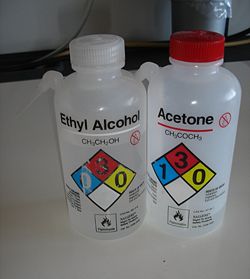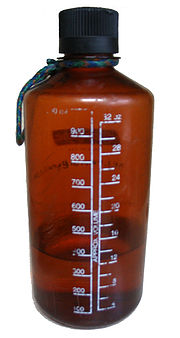
Nalgene
Encyclopedia

Polyethylene
Polyethylene or polythene is the most widely used plastic, with an annual production of approximately 80 million metric tons...
plastic developed and manufactured by Nalge Nunc International
Nalge Nunc International
Nalge Nunc International is a distributor and manufacturer of plastic laboratory containers that has diversified into the field of containers for outdoor sports and packaging materials...
originally developed for laboratory storage containers. It is now used in the manufacture of water containers, vials, bottles, bags and carboy
Carboy
A carboy is a rigid container with a typical capacity of 5 to 15 gallons . Carboys are primarily used for transporting fluids, often water or chemicals.They are also used for in-home fermentation of beverages, often wine.-Brewing:...
s for packaging, shipping, and storage. The name Nalgene is a registered trademark.
That original Nalgene line included such items as jar
Jar
A jar is a rigid, approximately cylindrical container with a wide mouth or opening. Jars are typically made of glass, ceramic, or plastic. They are used for foods, cosmetics, medications, and chemicals that are relatively thick or viscous...
s, bottle
Bottle
A bottle is a rigid container with a neck that is narrower than the body and a "mouth". By contrast, a jar has a relatively large mouth or opening. Bottles are often made of glass, clay, plastic, aluminum or other impervious materials, and typically used to store liquids such as water, milk, soft...
s, test tube
Test tube
A test tube, also known as a culture tube or sample tube, is a common piece of laboratory glassware consisting of a finger-like length of glass or clear plastic tubing, open at the top, usually with a rounded U-shaped bottom....
s, graduated cylinder
Graduated cylinder
A graduated cylinder, measuring cylinder or graduate is a piece of laboratory equipment used to accurately measure the volume of a liquid. Water displacement can be used to find out the volume of a solid. Graduated cylinders are generally more accurate and precise for this purpose than flasks and...
s, and Petri dish
Petri dish
A Petri dish is a shallow glass or plastic cylindrical lidded dish that biologists use to culture cells or small moss plants. It was named after German bacteriologist Julius Richard Petri, who invented it when working as an assistant to Robert Koch...
es helpful to laboratory workers, chemists, and biologists because they were shatterproof and lighter than glass. The properties of the respective plastics make them suitable for work with many materials in various temperature ranges.
Nalgene Outdoor
In the 1970s, conservationists began discouragingLeave No Trace
Leave No Trace is both a set of principles, and an organization that promotes those principles. The principles are designed to assist outdoor enthusiasts with their decisions about how to reduce their impacts when they hike, camp, picnic, snowshoe, run, bike, hunt, paddle, ride horses, fish, ski or...
the former reckless approach of disposing of can
Tin can
A tin can, tin , steel can, or a can, is a sealed container for the distribution or storage of goods, composed of thin metal. Many cans require opening by cutting the "end" open; others have removable covers. Cans hold diverse contents: foods, beverages, oil, chemicals, etc."Tin" cans are made...
s and glass containers by burning and burying in wilderness and recreation areas, and some places began forbidding such materials by regulation. Thermo Scientific Nalgene products became popular replacements among backpackers for storing consumables; the light, wide-mouthed, HDPE
High density polyethylene
High-density polyethylene or polyethylene high-density is a polyethylene thermoplastic made from petroleum. It takes 1.75 kilograms of petroleum to make one kilogram of HDPE...
and Lexan
Lexan
Lexan is a registered trademark for SABIC Innovative Plastics' brand of polycarbonate resin thermoplastic. Polycarbonate polymer is produced by reacting bisphenol A with carbonyl dichloride, also known as phosgene. Lexan is the brand name for polycarbonate sheet and resin in a wide range of grades...
bottles were more secure than plastic bags, and found use for both liquids and solid foods.

Products originated by other manufacturers, that are designed for compatibility with this item's overall dimensions or its 2.5 inch neck include:
- Screw-on water-purifying filters
- Stainless-steel collapsible-handle cups, for drinking and/or stove-top cooking, that store compactly with a Nalgene litre-bottle nested inside them
- Insulated Nylon-fabric cases for Nalgene 1 litre bottles; features include stable attachment points and, in most cases, nesting for a cup
- Snap-in plastic "splash guards" that narrow the neck opening to a size where drinking while in motion is less likely to cause spilling
- Screw-in filters, which allow the user to add coffee grounds or tea, pour boiling water over the contents, seal the lid, and brew the beverage.
- Screw on LED lights, creating a usable lantern with low power consumption.
Another widely available Nalgene Outdoor product is a 650-ml (22-fl oz) "All-Terrain" or "bike" bottle. The bottle itself is LDPE, and its screw top has two moving parts: a drinking nozzle that seals until snapped open by pulling on it, and a hinged Lexan dome, that when closed both snaps the nozzle closed and protects the nozzle against contamination. Unlike traditional Nalgene containers, this item can be damaged and potentially ruined by filling it with very hot water.
Recently, Nalgene has added hydration system
Hydration system
In recreation and other sustained outdoor activities, a hydration system is an apparatus intended to help its user in drinking enough liquid to support the physical effort involved in the activity. Such systems for consumers were first sold to cyclists, but by the 1990s also had found a...
s to its cycling and wilderness product line. The line features 1- to 3-litre bladders with hose-and-bite-valve assemblies in small back-carried packs (mostly under 1000 cubic inches (16 L) of additional storage). Nalgene offers the option of two different bladder materials for a choice of superior taste and bacteria resistance versus improved durability. In addition, the bladder on these products can be quickly detached from the hose and pack by a self-sealing connector on the bladder. These features seemed aimed at dissatisfaction in traditional hydration systems with problems of awkward filling and/or spilling water into gear that shares the pack.
Increased awareness of the importance of hydration - and perhaps a fad
FAD
In biochemistry, flavin adenine dinucleotide is a redox cofactor involved in several important reactions in metabolism. FAD can exist in two different redox states, which it converts between by accepting or donating electrons. The molecule consists of a riboflavin moiety bound to the phosphate...
of wilderness chic
Wilderness chic
Wilderness chic is a fashion trend centered around the look of hikers, climbers, and mountaineers.Among the most popular brands are Arc'teryx, Columbia Sportswear, The North Face, , Patagonia, REI, Mountain Hardwear, 66° North, Marmot, Merrell boots and Jack Wolfskin...
- has led to the appearance of some Nalgene containers in urban and suburban settings like gyms, offices, and campuses. Many colleges give or sell Nalgene water bottles to their students, and Nalgene bottles are also customized and sold as retail promotions.
Controversy
In 1997 Nalgene was targeted in a nationwide boycottBoycott
A boycott is an act of voluntarily abstaining from using, buying, or dealing with a person, organization, or country as an expression of protest, usually for political reasons...
by campus-based animal rights
Animal rights
Animal rights, also known as animal liberation, is the idea that the most basic interests of non-human animals should be afforded the same consideration as the similar interests of human beings...
activists for products used in animal experimentation. The majority of company criticism was directed towards a Nalgene device that prevents rabbit
Rabbit
Rabbits are small mammals in the family Leporidae of the order Lagomorpha, found in several parts of the world...
s from breaking their own backs during pyrogen testing. The company has responded with an official statement that it supported research "conducted only within the guidelines of the federal Animal Welfare Act
Animal Welfare Act
The Animal Welfare Act was signed into law by President Lyndon B. Johnson on August 24, 1966. It is the only Federal law in the United States that regulates the treatment of animals in research, exhibition, transport, and by dealers...
and only when necessary."
BPA concerns and resolution
In recent years, studies have suggested that polycarbonatePolycarbonate
PolycarbonatePhysical PropertiesDensity 1.20–1.22 g/cm3Abbe number 34.0Refractive index 1.584–1.586FlammabilityV0-V2Limiting oxygen index25–27%Water absorption – Equilibrium0.16–0.35%Water absorption – over 24 hours0.1%...
plastics such as the ones Nalgene used may leach endocrine disruptors. Nalgene denies that the quantity leached from their products posed a significant threat to health. Among the secreted chemicals, Bisphenol A
Bisphenol A
Bisphenol A is an organic compound with two phenol functional groups. It is used to make polycarbonate plastic and epoxy resins, along with other applications....
(BPA) is a concern as it binds to estrogen receptor
Estrogen receptor
Estrogen receptor refers to a group of receptors that are activated by the hormone 17β-estradiol . Two types of estrogen receptor exist: ER, which is a member of the nuclear hormone family of intracellular receptors, and the estrogen G protein-coupled receptor GPR30 , which is a G protein-coupled...
s, thus altering gene expression
Gene expression
Gene expression is the process by which information from a gene is used in the synthesis of a functional gene product. These products are often proteins, but in non-protein coding genes such as ribosomal RNA , transfer RNA or small nuclear RNA genes, the product is a functional RNA...
. Other research has found that fixatives in polycarbonate plastics can cause chromosomal error in cell division called aneuploidy
Aneuploidy
Aneuploidy is an abnormal number of chromosomes, and is a type of chromosome abnormality. An extra or missing chromosome is a common cause of genetic disorders . Some cancer cells also have abnormal numbers of chromosomes. Aneuploidy occurs during cell division when the chromosomes do not separate...
. Nalgene claims these chemicals are only potentially released from Nalgene products when used at temperatures outside of the designed range.
In November 2007, national Canadian co-operative retailer Mountain Equipment Co-op
Mountain Equipment Co-op
Mountain Equipment Co-op is a Canadian consumers' cooperative, which sells outdoor recreation gear and clothing to its members exclusively. MEC is notable for its commitment to environmental protection and other causes. As a co-op, MEC sells only to customers who hold a lifetime membership, which...
removed all hard, clear polycarbonate plastic water bottles (including Nalgene-branded product) from their shelves and replaced them with BPA-free Nalgene bottles. In December 2007, Lululemon made a similar move. In May 2008, REI
Rei
-People:*Rei, the Biblical term for those who retained their allegiance to King David when Adonijah rebelled, as mentioned in 1 Kings 1:8*Rei Hiroe*Rei Igarashi*Rei Kawakubo*Rei Kikukawa*Rei Mikamoto*Rei Munakata*Rei Okamoto*Rei Omishi...
removed Nalgene-branded polycarbonate water bottles and replaced them with BPA-free Nalgene bottles.
On April 18, 2008, Health Canada
Health Canada
Health Canada is the department of the government of Canada with responsibility for national public health.The current Minister of Health is Leona Aglukkaq, a Conservative Member of Parliament appointed to the position by Prime Minister Stephen Harper.-Branches, regions and agencies:Health Canada...
announced that Bisphenol A is "'toxic' to human health". On the same date, Nalgene announced it would phase out production of its Outdoor line of polycarbonate containers containing the chemical Bisphenol-A (BPA). Nalgene subsequently adopted a BPA-free product made by Eastman
Eastman Chemical Company
Eastman Chemical Company is a United States based chemical company, engaged in the manufacture and sale of chemicals, fibers, and plastics. Eastman has 11 manufacturing sites in seven countries, supplying its products throughout the world...
, TritanTM copolyester
Copolyester
Copolyester forms when modifications are made to polyesters, which are combinations of diacids and diols. For example, by introducing other diacids, such as isophthalic acid , or other diols, such as cyclohexane dimethanol to the polyester polyethylene terephthalate , the material becomes a...
, as a substitute.

